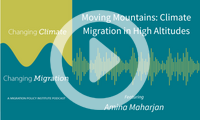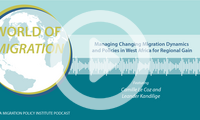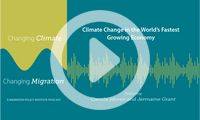Remittances
Recent Activity

This episode of Changing Climate, Changing Migration speaks with Amina Maharjan from the International Centre for Integrated Mountain Development about the unique climate migration issues that are witnessed in mountain regions.

MPI Europe Associate Director Camille Le Coz discusses migration dynamics in West Africa and and how African leaders are responding to these trends with Leander Kandilige, a senior lecturer at the Centre for Migration Studies at the University of Ghana.

This expert conversation reviews migration in nine Caribbean countries, outlining challenges and opportunities for the integration of the migrant population and a successful engagement with diasporas to advance development, along with recommendations to strengthen the region’s capacity to accommodate changing patterns of migration.

En este webinar, expertos del Banco Interamericano (BID) y el Migration Policy Institute (MPI) presentaron las principales conclusiones de su nueva publicación sobre la realidad migratoria de la región y compartieron algunos de los desafíos y oportunidades para la integración de la población migrante y para capitalizar el potencial de sus diásporas como un impulso para el desarrollo.

Guyana is a small country in South America that will be greatly transformed by the recent discovery of massive offshore oil reserves. This episode of Changing Climate, Changing Migration discusses how the world’s fastest growing economy is confronting environmental change, particularly with economic growth and proximity to troubled Venezuela likely to drive significant immigration.
Pages
Recent Activity
Some of the strictest COVID-19 pandemic-era limits on human mobility occurred in the Asia Pacific region. Border closures started in East and Southeast Asia in early 2020 and quickly spread through the entire region, in some cases remaining in place for more than two years. This report examines the approaches countries took and reflects on the immense costs and benefits of using border measures to tackle public-health risks.

















Beyond the Border: Opportunities for Managing Regional Migration between Central and North America
A Race Against the Clock: Meeting Seasonal Labor Needs in the Age of COVID-19
The Lampedusa Tragedy Prompts the Question: Does the UN Have Any Impact on the World’s Migrants?